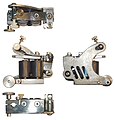Tattoo machine
A tattoo machine is an electrically operated technical device for the production of tattoos by applying tattoo inks to the human skin and the standard tool of a modern tattoo artist .
history
The basic model of a tattoo machine was a device that Thomas A. Edison had patented in the USA in 1877 with the designation stencil pens. Originally, the device was developed for engraving objects. Later, Samuel O'Reilly discovered that Edison's machine, when rebuilt, was capable of piercing ink under the skin. For the first time in 1891, Samuel O'Reilly had a tattoo machine, a tattoo gun, patented. The New York tattoo artist Charlie Wagner applied for a patent for a tattoo machine in 1904. Since O'Reilly was an apprentice at Wagner, there is sometimes a dispute about which of the two is considered to be the inventor of the electric tattoo machine. The tattoo artist Christian Warlich was the first in Germany to use an electric tattoo machine.
Another tattoo machine works with an electric motor. This rotary machine was designed and manufactured in Germany from 1970 to 1978 by tattoo artists Horst Klassenbach and Manfred Kohrs . There are also pneumatic machines on the market.
technology
Solenoid machine
In a solenoid machine z. B. with the help of two coils, a magnetic field is generated that moves a number of fine needles soldered to a rod quickly back and forth.
Rotary tattoo machine
With the rotary tattoo machine (rotary machine) a rotary movement is generated by means of an electric motor, which is converted into the necessary upward and downward movement by means of an eccentric . The rotary machine is mostly used in the cosmetic field for permanent make-up by tattoo artists for very fine lines or shading. In contrast to the magnetic coil machine, the tattoo machine, which is driven by an electric motor, runs more smoothly and is also considerably faster with up to 18,000 strokes per minute.
Rotary machine "Kohrs 1978" (Liner), art gallery fürth 2015.
Uses
A tattoo machine for lines is called a "liner" and for shading it is called a "shader". There are now numerous variants of the two machine models that work with settings for liner or shader. In the meantime, many tattoo artists work with Tat-Guns (tattoo guns, dt. "Tattoo guns") with which one can tattoo shadows as well as lines. Most new machines have the ability to adjust the depth, speed and strength of the stitch. The ink stays between the needles thanks to the capillary action and is brought into the skin by the speed of movement.
Legal basis
On May 1, 2009, the Tattoo Inks Ordinance (TatV) came into force. Basics are regulated in the Food, Consumer Goods and Feed Code (LFGB), the TatV also specifically regulates the labeling, as well as notification obligations and prohibited ingredients. The tattoo inks also include the means for permanent make-up. A regulation on the nature of the technical equipment, such as B. the tattoo machine does not currently exist. The hygienic condition of the machines is regulated by the respective hygiene regulations of the federal states .
In Austria, tattooing and piercing are regulated in the ordinance of the Federal Minister of Economics and Labor on the rules for piercing and tattooing by cosmetics (beauty care) traders .
In Switzerland, the requirements for tattooing are mainly regulated in the Human Contact Ordinance (HKV Art. 3-9) and in the Ordinance on Cosmetic Products (VKos, SR 817.023.31).
Trivia
Since tattoos are still popular in prisons, inmates make tattoo machines out of any material.
For the production of tattoo machines find z. B. Electric shaver use. Cannulas or sewing needles are connected, for example, to a ballpoint pen tip, which serves as a handle and paint tank.
See also
Web links
- Rotary tattoo machine 1978 K in operation (film by Dr. Ole Wittmann , Foundation Historical Museums Hamburg ).
Individual evidence
- ↑ Victoria Groß: skin engravings - for the individualization of the body . P. 10
- ↑ Tattoo magazine 01/12: Tattoo machines. "A doorbell with a needle and ink". Retrieved April 6, 2015 .
- ^ Museum of Hamburg History: Contributions to German Folklore and Classical Studies, Volumes 11–12. Verlag Museum für Hamburgische Geschichte 1967, p. 107.
- ^ Samuel M. Steward : Bad Boys and Tough Tattoos , Routledge London & New York, p. 190. ISBN 0-918393-76-0
- ↑ Tattoo Nation Tattoo Magazine: How it works - Tattoo Machine , Issue # 1 of July 10, 2014, p. 35.
- ↑ tattooing1.blogspot.de. Retrieved October 24, 2013 .
- ↑ reinMein the local magazine: Das Tattoo-Kunsthandwerk - a technique that gets under the skin, accessed on June 20, 2012
- ↑ bvl.bund.de: Legal framework. Retrieved July 26, 2013 .
- ↑ Hygiene Ordinance of the Lower Saxony Ministry for Women, Labor and Social Affairs of August 17, 2001
- ↑ StF: BGBl. II No. 141/2003
- ↑ (PDF) Leaflet for assessing tattoo and permanent make-up colors as well as piercings as part of self-control.
- ↑ Robert: Stories under the skin. In: unique-online.de. Retrieved August 14, 2016 .
- ↑ Klaus Pichler: Drawn for life - prison tattoos and their wearers. Fotohof Edition Verlag 2011.
- ↑ Guns, tattoo machine, brandy burner. The illegal handicrafts of the thugs. Retrieved September 15, 2013 .
- ↑ Annegret Stephan, Klaus-Dieter Müller (ed.): The past does not let us go: prison conditions of political prisoners in the Soviet zone / GDR and their health consequences . Arno Spitz 1998, ISBN 3-870-61812-4 , p. 93.
- ^ Museum Digital Baden-Württemberg: Improvised tattoo machine with Remington razor










